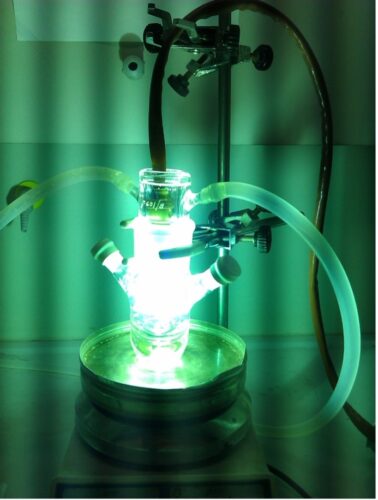Image courtesy of Wikimedia Commons.
Last August, a collaboration between the Hammes-Schiffer and Mayer groups at Yale and researchers from the Hammarström group at Uppsala University led to the discovery of a new fundamental photochemical reaction relevant to our understanding and application of chemistry.
The finding follows unexpected results the groups observed in 2019 when working with the motif anthracene-phenol-pyridine (An-PhOH-Py), which contains the three chemical groups connected by single bonds. The teams found that when different variations of the An-PhOH-Py motif are excited with light, the only some of their molecules go through a known pathway: the molecule starts at the ground state, the anthracene subunit absorbs light energy, and that new energy promotes an electron to move from the phenol subunit to the excited anthracene (*An). At the same time, a proton transfers to the pyridine unit to form a new charge-separate state (CSS). This CSS represents a different arrangement of charge and energy in the molecule that can be utilized later in reactions like photosynthesis. The researchers discovered that molecules return from the CSS to the ground state through a proton-coupled electron transfer (PCET) process that is slowed down by increasing the driving force. Surprisingly, the groups did not observe any CSS for certain variations of their molecules. Speculating that there was some other way for these molecules to react to light and yield a lower energy product, researchers computationally predicted and experimentally detected the formation of a local electron-proton transfer (LEPT) excited state in place of a CSS for some of their reagents.
The LEPT itself isn’t new. A PhOH-Py molecule can be excited to trigger an excited-state proton transfer and give us a *PhOH-Py LEPT species. Similarly, the PhOH-Py fragment in the An-PhOH-Py triad can be excited to a LEPT state (*PhOH-Py). The direct transformation from the excited anthracene fragment in the An-PhOH-Py triad to the excited PhOH-Py fragment LEPT (as confirmed by further experiments), however, goes beyond existing theories, hinting at a new photochemical reaction responsible for these observations.
With further research, it became clear that that was exactly the case! Researchers described a new reaction where a proton transfer within the PhOH subunit is coupled to an energy transfer from the *An to the PhOH subunit without a charge separation. Rather than the reaction involving proton and electron movement, it relies on a proton and energy moving throughout the molecule in a new way that had never been observed.
This reaction, appropriately coined a proton-coupled energy transfer (PCEnT), also challenges our rules about light absorption and fluorescence. Since the energy to excite the LEPT state comes from the *An, the fluorescence energy from the *An has to match the absorption energy of the PhOH-Py. However, according to Coraline Tao, a senior PhD student in the Hammes-Schiffer Lab at the time of the project and now a postdoctoral researcher at the University of Pennsylvania, the observed fluorescence of LEPT from *An runs counter to expectation. “[LEPT’s fluorescence [is] counterintuitive because [the] energy giver has to have enough energy to charge the acceptor, but here they don’t,” Tao said. Where does that extra energy come from? The groups show that the proton transfer can physically reconfigure the molecule, making this fluorescence possible. The details of how the transferring proton couples with the energy transfer process, however, are still unclear, prompting questions about how spatial relationships contribute to energy movement across molecules.
Often, fundamental discoveries have a curious tendency to pop up in many unexpected places—think the Schrödinger equation used in economics. This is no different. PCEnT describes a powerful process that could have significant future applications. Since the LEPT product is closer in energy to the *An intermediate than other reagents we could use to get the same thing, there is now a way of executing this chemical transformation using lower excitation energy. According to Tao, this could have important implications for designing molecules for solar dyes, solar panels, and other technologies to store and use photochemical energy. PCEnT may also already be present in photosensitive biological systems, and we haven’t thought to look! It could be the case that differences between PCET, PCEnT, and other photochemical reactions serve as regulatory mechanisms for biological pathways. This new knowledge of PCEnT also allows researchers to access new configurations and arrangements of molecules that could be synthetically or technologically useful.

